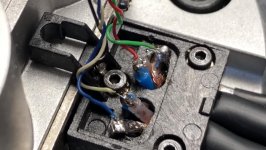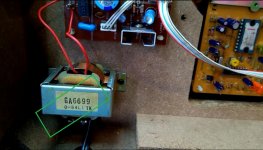Well in this case I have BBC4 to thank. They do music programs on a friday night.
And aren't they good, two recent ones, on drumming and guitar, I was amazed at Van Halen's ability.
If TV was as solid as this on many more subjects, and for much more of the time, it would justify the licence fee. (tax).
I am happy to report though that this is not were the problem came from. So the coast is clear to do some measurements.
But not today, the weather is just brilliant, and before we all get locked down, I will be going out for a long bike ride.
Stay safe,
Paul
Thanks Paul
Well, heuristic skills is one of the masks of stubbornness (I wouldn’t be able to sleep at night if I had an untraceable hum problem with my TT)
So now that I know you are a bicyclist, I am asking you to spare 5 more minutes to ‘run the last mile’ for verifying the root of the hum.
Unplug the TT from mains.
(With preamplifier switched off ) unplug the TT interconnect from the preamplifier .
Remove the headshell from the tonearm.
Using an Ohmmeter :
A. Measure between Earth single wire Y spade and both RCAs outer barrel, one at a time. If there is no continuity, you confirm that the arm’s internal wiring and interconnect are configured as floating.
B. Check for continuity between all four connections at the arm’s front receptacle where the headshell plugs and the RCAs plugs.
C. Check for continuity between arm’s metal body and Earth wire Y spade.
Reinstall the headshell (with the cartridge in place) on the tonearm
Using the Ohmmeter set at low Ohms range:
D. Measure between Earth wire Y spade and both RCAs outer barrel, one at a time. If there is no continuity, you confirm that the cartridge’s electrical connection is floating.
E. Measure resistance between inner pin and outer barrel on each RCA plug. There should be the same value on L and R channels.
F. Check for continuity between headshell metal body and Earth wire Y spade.
At the rear side of tone arm’s base, remove the cover and visually check for proper connection between the arm’s internal wiring [5 wires, red(+) green(-) for R, white(+) blue (-) for L, black for arm’s body] and the interconnect, plus single Earth wire. Reinstall the cover if all found OK.
Then I would unscrew the lower base of the TT and unplug /replug all the wire connectors found there.
Next I would check where I should best connect the Earth wire Y spade at the preamplifier.
Paul, are you still reading
George
Attachments
George, aren’t bodies of MM carts most of the time connected to one of the two gnd pins ?Paul, are you still reading?
George
And isn’t this body connected via headshell and arm to the Earth wire ?
What you describe is exactly what is needed for a balanced connection, but with MM cart’s that’s not always possible unless you isolate the body from the shell.
For MC cart’s there is no such problem.
Question is, what has Paul, MM or MC ?
Hans
Hi George, Hans,
Just back from 2 1/2 hours pedaling. Thank you very much for your inputs.
The wiring was exactly done as shown in the picture George posted. The four thin wires (black/white and red/green) run through the tone arm to a connector to which the cartridge shell can be screwed on. All wires connect separately to the cartridge shell and none is grounded. The shield is connected to ground at the pre-amplifier side. For grounding the turntable and tone arm, a separate wire runs from the turntable to the pre-amplifier.
The cartridge is a Denon DL-103r MC element.
Since I already mounted balanced cabling, it is hard to go back to the original situation, but I measured the old wiring OK on several occasions. The reason for repeated measurements in the past being that I never could get rid of unwanted signal pick up since I bought the bloody turntable almost 40 years ago.
Tomorrow I will do some measurements where I ground black and green at the pre-amplifier side and see if the interference comes back. As all my ventures in audio, it is basically because I am not happy with something I hear. So, like in Bonsai's case, when a single ended connection works fine, I would definitively not touch it.
To be continued.
Just back from 2 1/2 hours pedaling. Thank you very much for your inputs.
The wiring was exactly done as shown in the picture George posted. The four thin wires (black/white and red/green) run through the tone arm to a connector to which the cartridge shell can be screwed on. All wires connect separately to the cartridge shell and none is grounded. The shield is connected to ground at the pre-amplifier side. For grounding the turntable and tone arm, a separate wire runs from the turntable to the pre-amplifier.
The cartridge is a Denon DL-103r MC element.
Since I already mounted balanced cabling, it is hard to go back to the original situation, but I measured the old wiring OK on several occasions. The reason for repeated measurements in the past being that I never could get rid of unwanted signal pick up since I bought the bloody turntable almost 40 years ago.
Tomorrow I will do some measurements where I ground black and green at the pre-amplifier side and see if the interference comes back. As all my ventures in audio, it is basically because I am not happy with something I hear. So, like in Bonsai's case, when a single ended connection works fine, I would definitively not touch it.
To be continued.
@Bob: I was more thinking '**** you we're from texas'
The program is on youtube YouTube hopefully not country locked. Knowing that, even in the 21st century some musicians like to record standing around a single microphone makes me very happy. That to me is music making in a pure and wonderful form. I also love Rich Hall as a presenter which makes the program more enjoyable and very informative to those of us not from the mountains.
I love what he does up on the neck..... for lack of better term ‘strumming with the fretting hand’ I looked to see if that’s a thing or not but find no mention of it anywhere.
If only I had 2+ hours a day to go cycling!
What about a similar solution to take your children with you.
They will love it.
Hans
Attachments
Hello Vac.In my case, I have a turntable that I never have been able to get reasonably noise free. Especially hum. Yamaha GT-750. Because I want to play my albums again, I decided to try a balanced setup. And this totally solved the problem, to the point that I have never heard less noise coming from a turntable.
I have an 80s Akai DD TT (single ended connections) that had very low level hum despite arm, chassis and signal earthing arrangements all being in order.
I found the solution to hum free listening was to remove the small fully shielded transformer and mount it externally and away from the signal wiring and cabling.
Just a suggestion of what not to overlook.
Max.
Last edited:
The transformer in Paul’s turntable is magnetically unshielded but of good quality. If and when he’ll decide to look inside, he will check the two wires going from the transformer’s secondary to the rectifying bridge and twist them tight together. He will also check and do the same on the wiring from the psu board to the motor coils.
I would also reorient the transformer angularly to bring the core side face the cartridge at it’s travel.
SNR specs for that turntable is 82dB (I don't know with what cartridge they 've measured it.
The DL103 has an issue with magnetic field interference, it's body is unshielded.
George
I would also reorient the transformer angularly to bring the core side face the cartridge at it’s travel.
SNR specs for that turntable is 82dB (I don't know with what cartridge they 've measured it.
The DL103 has an issue with magnetic field interference, it's body is unshielded.
George
Attachments
Hi HansGeorge, aren’t bodies of MM carts most of the time connected to one of the two gnd pins ?
Many (most) of them
Yes. And there we have the ground loop formed by the separate arm’s earthing wire and the shields of the coaxial cable.Earthing wire and coaxials have to be twisted together and the point of attachment of the earthing spade has to be as close (physically and electrically) as possible with the point where the RCA barrels are.And isn’t this body connected via headshell and arm to the Earth wire ?
Now very often, this is not the case. The spade contact point is universaly the metal case of the preamplifier but the barrel of the RCA many times is not bonded to the case, and if it is, it is not at the same location with the arm’s earthing spade.
That’s correctWhat you describe is exactly what is needed for a balanced connection, but with MM cart’s that’s not always possible unless you isolate the body from the shell.
I haven’t worked with many of them. On two-three that I’ve seen their construction (Denon is the one), they don’t have a conducting path from the – pins to the headshell.For MC cart’s there is no such problem.
Now we know. DL103RQuestion is, what has Paul, MM or MC ?
George
What about a similar solution to take your children with you.
They will love it.
Hans
Hi Hans,
Did look at those, but not big enough for both of the kids. Really the boy needs to go on a kiddy krank off the back but combination of storage, my suitable bike being bust and wife not really sure about carrying one of the kids has put it on hold. Maybe a triplet is the answer.
I take time to come to decisions on things. Only in January did I get a new bike for the ride to work after 10 years of nursing a 26 year old bike I bought cheap to get me through one winter. Now I have a commuter bike of silly good spec just as the hybrid for family rides fell apart.
Back on balanced phono. When I get some time, Wayne Kirkwood did measure SE vs diff for a DL-103 in a hostile environment ( on the bench next to the UPS) and I'll find those plots. There is differential mode pickup you can do little about.
Yes, I found moving the tt power transformer far as possible away from the arm/MM cartridge effected the hum cure.What differential mode can not do anything about is the magnetic interference that is being picked up by the cartridge coil.
Once picked up by the coil, it becomes a differential signal.
IME for single ended connection once earthing arrangements are correct mm cartridge stray magnetic pickup dominates, it is surprising how sensitive mm carts are despite cart shielding.
Yes, I found moving the tt power transformer far as possible away from the arm/MM cartridge effected the hum cure.
IME for single ended connection once earthing arrangements are correct mm cartridge stray magnetic pickup dominates, it is surprising how sensitive mm carts are despite cart shielding.
I suspect that MC’s are less sensitve to EMR despite their lower sensitivity, so let’s say MC output*10 < MM output because of EMR.
Would be interesting to test, because in that case MC’s could have more benefit of Balanced connections.
Hans
Yes, I found moving the tt power transformer far as possible away from the arm/MM cartridge effected the hum cure.
.
As part of an ongoing belt+braces+ extra belt I have seriously considered battery powering one of my turntables silly though it is. For Lolz I could then run off batteries all the way to the power amps in the speakers. referenced to vinyl noise floor this is a silly thing to do, but I've done sillier and have the bills to prove it
As part of an ongoing belt+braces+ extra belt I have seriously considered battery powering one of my turntables silly though it is. For Lolz I could then run off batteries all the way to the power amps in the speakers. referenced to vinyl noise floor this is a silly thing to do, but I've done sillier and have the bills to prove it
Try everything and keep the goodies. Just do it.
Hans
Hello Hans.I suspect that MC’s are less sensitve to EMR despite their lower sensitivity, so let’s say MC output*10 < MM output because of EMR.
Would be interesting to test, because in that case MC’s could have more benefit of Balanced connections.
Sure, MC is a whole different ballgame to MM ie less windings and lesser loading resistance so ought to be much lower sensitivity to stray magnetic fields.
Hello Bill.As part of an ongoing belt+braces+ extra belt I have seriously considered battery powering one of my turntables silly though it is. For Lolz I could then run off batteries all the way to the power amps in the speakers. referenced to vinyl noise floor this is a silly thing to do, but I've done sillier and have the bills to prove it
Perhaps not so crazy powering your tt and preamps from isolated DC, this will eliminate longitudinal leakage which is discriminated as noise signal in an unbalanced system.
Every bit of noise in a high gain system causes signal degradation, every improvement is important.
Max.
Hello Hans.
Sure, MC is a whole different ballgame to MM ie less windings and lesser loading resistance so ought to be much lower sensitivity to stray magnetic fields.
Max.
Actually it works like this- a low impedance source will short out an capacitive coupling but provide a low impedance path for magnetic coupling. A Hi-Z source allows for capacitive coupling but little current can flow so low magnetic noise.
Good practice is to twist the two conductors close together to minimize the area between which is where the magnetic pickup comes from and to shield as completely as possible the cable for electrostatic pickup, not sharing with any signal or return line. If the shield and the return are shared then electrostatic coupling to the shield will be in series with the source and the input cannot tell them apart. All the tonearms I have seen (made since about 1950 or so) have this type of construction. Usually you will have a separate ground wire for the shield in the tonearm and should have one for the motor circuits as well.
- Home
- Member Areas
- The Lounge
- The Black Hole......


